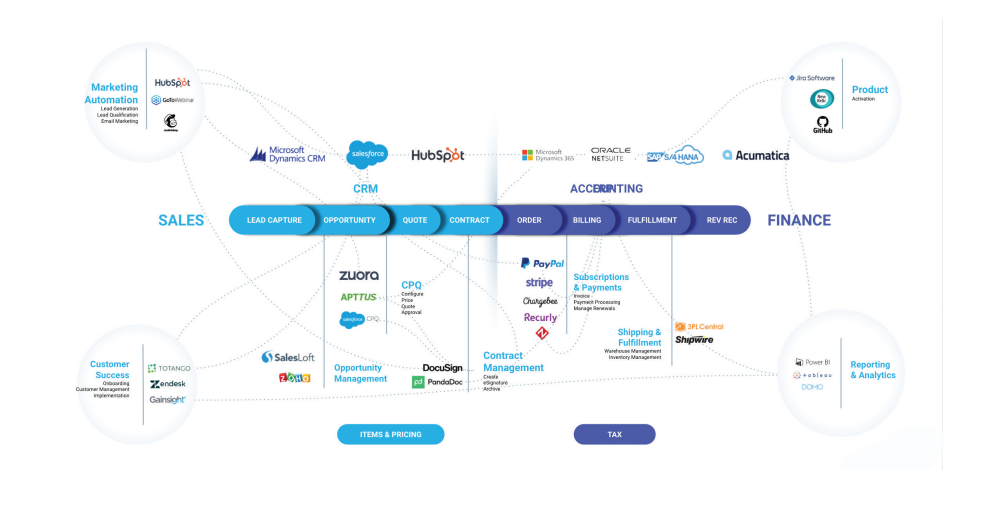
Hundreds of applications. Thousands of business processes. Millions of combinations. ONE iPaaS.
Evaluating the Options
Vendor Provided (Native) Integrations
Many SaaS applications provide point-to-point integrations to popular hub applications like Salesforce or NetSuite to meet common use cases, enabling business system administrators to configure the integration to exchange data between two applications. These solutions are a good fit for automations based on simple integration scenarios with a limited number of application endpoints and integration flows.
Benefits
- Fast and easy to configure and implement
- Relatively inexpensive. Although customers often have to subscribe to higher-tier versions to get access to APIs and integration services.
Challenges
- Limited functionality and extensibility: They address only common use cases and provide limited (or no) ability for customization.
- Decentralized: Packaged integrations, like SaaS applications, are often sourced and implemented by business teams to address specific business problems and limit the organization’s ability to address more complex business processes that span multiple systems.
- Difficult to manage at scale: Requires technical resources to learn and work in multiple applications to manage automations and troubleshoot problems. Visibility and error handling is limited, often with no ability to recover without resending records or manually rekeying data. As the number of point-to-point integration grows, the risk of non-compliance with data security and privacy standards becomes significant.
Scalability Rating: 1/5
Coded Point-to-Point Integrations
Skilled developers write code to integrate to APIs, which can be performed by salaried, internal resources or outsourced to external resources like a VAR or SI. An API integration tool, like Cloud Elements, may be used to help expedite the integration development or developers just code directly to the API. Custom code was the default option for on-premises software and is still common in organizations with development teams who have the bandwidth to implement, manage and maintain integrations, or smaller businesses who have a limited number of custom integration requirements.
Benefits
- Unlimited extensibility: Developers can customize integrations to meet virtually any business or technical requirement.
- Minimal barrier to entry: Businesses can outsource development for a single custom integration if that meets their requirement.
Challenges
- Time-to-value: Custom coding is the most time-intensive option for integration.
- Implementation cost: In-house development resources are expensive to hire and retain, and organizations need to have sufficient demand to be able to fund a development team as well as business needs driving interesting projects in order to retain quality developers. Hiring outside resources doesn't require commitment, but hourly rates for skilled developers are high. Depending on IT staff skill sets, there can be additional costs for business analysis, architecture and design as well as project management.
- Continuity: Developer turnover is generally high and is particularly high in the current labor market. Without quality documentation – which is extremely rare outside larger enterprises and global systems integration firms – developers take their knowledge of the integrations with them. When custom integrations inevitably break down without documentation, they often need to be rebuilt from scratch resulting in potentially lengthy downtime.
- Endpoint management: Without a process for managing notifications from endpoint applications about API changes, integrations will stop and require recoding, also resulting in downtime.
- High total cost of ownership (TCO): In addition to implementation, technical resources are required to maintain and manage integrations as business teams have no visibility to errors or any ability to modify to meet business processes changes without IT. IT will need to resolve any integration errors, and if integrations are mission-critical and time sensitive, will need to provide support to meet service-level agreements.
Scalability Rating:
- Outsourced Development: 1/5
- In-House Development: 3/5
Robotic Process Automation
Robotic process automation (RPA) is a “screen-scraping” technology that allows a user to build scripts (commonly referred to as “bots”) to automate processes and integrate any application through the user interface and a control dashboard/orchestrator. It is well-suited to automation of routine, repetitive, rules-based, predictable tasks using structured digital data. These bots can be used to automate tasks within an overall business process including manipulating data, passing data to and from multiple different applications, triggering responses, or executing transactions.
Benefits
- No back-end integration or API is needed: RPA works through the user interface, in effect mimicking the actions of a user.
- Business users can create automations: RPA doesn’t require coding or programming knowledge. Solutions are designed for ease of use with minimal training requirements.
- Time-to-value: RPA automations are generally implemented in days (or even hours in the case of the simplest of processes.)
Challenges
- Limited to simple, repeatable processes: Non-standard processes, long or complex processes, processes which change often, or any processes that require human interaction are not suited to automation through RPA.
- Complex to manage at scale: RPA tools are ultimately a collection of scripts that cannot adapt to changes. Updates or replaced applications in a process will result in a failure or incorrect. Troubleshooting and error management of automations is generally a challenge as only a handful of enterprise-class solutions provide robust governance capabilities.
- Limited impact and ROI: In effect, RPA bots are performing the same manual processes as before, albeit faster and without costly human interaction. Organizations investing heavily in RPAcentric initiatives over more comprehensive automation and integration technologies will find it challenging to meet increasingly broad and complex automation needs.
Scalability Rating: 2/5
About Celigo
At Celigo, we enable breakaway growth, controlled cost management, and superior customer experiences by ensuring that every process – at any level of the organization – can be automated in the most optimal way. The Celigo platform is a complete integration platform as a service that allows business users and developers alike to automate both common and custom business processes and move the management of them into the teams that own that process, enabling business teams to innovate faster and become more agile while providing IT with the capabilities they need to ensure unified best practices, data security and scalability to meet the needs of the business today and in the future
Contact Us for more information on automating your business processes with Celigo for your Business.
Copyright © 2025 - Custom Software Solutions, Inc.







